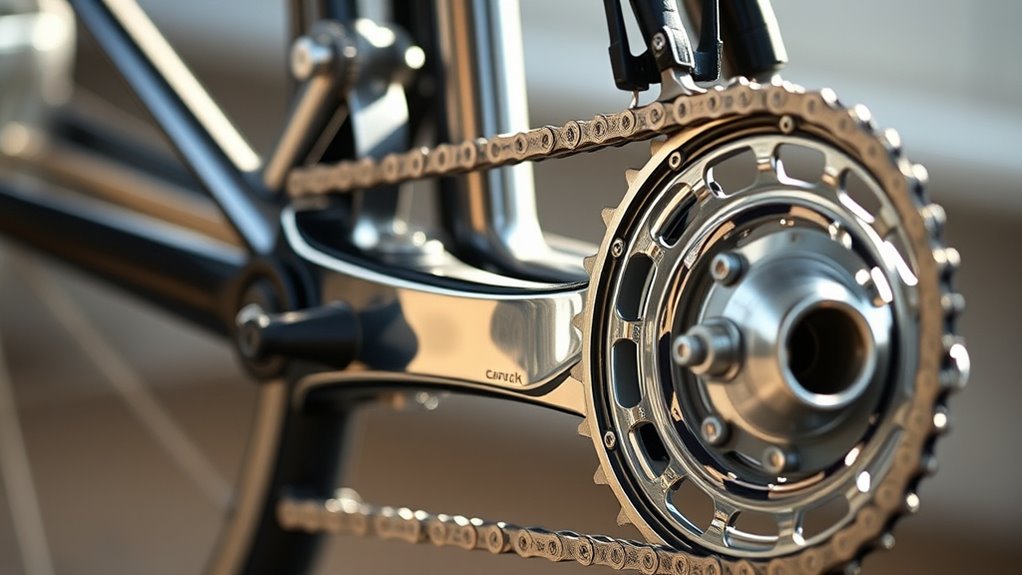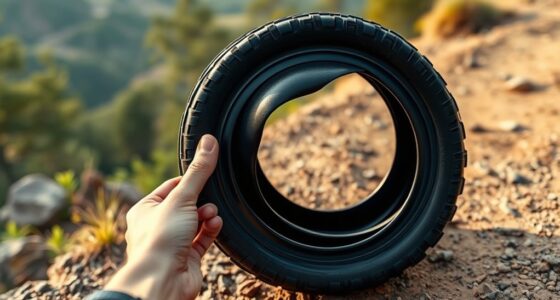A proper chainline guarantees your drivetrain runs smoothly and efficiently by aligning the chain directly between the front chainring and rear cassette. When your chainline is correct, shifting feels seamless, and components wear less over time, saving you money. Misalignment causes awkward shifts, increased stress on parts, and faster wear, which reduces overall efficiency. Keeping your chainline dialed in maximizes power transfer and prolongs component life—continue for tips on achieving ideal alignment.
Key Takeaways
- Proper chainline ensures smooth shifting and reduces chain stress, enhancing overall drivetrain efficiency.
- Correct alignment minimizes unnecessary chain angles, decreasing wear and prolonging component lifespan.
- Optimized chainline improves power transfer by maintaining consistent chain tension during pedaling.
- Proper setup prevents gear skipping and slipping, leading to more responsive and efficient gear changes.
- Regular maintenance and proper component selection help sustain ideal chainline, maximizing drivetrain performance.

Have you ever wondered how your bike’s chainline affects its overall performance? It might seem like a small detail, but it plays a vital role in how smoothly and efficiently your drivetrain works. The chainline is fundamentally the straight line that runs through the center of your chain, connecting the front chainring to the rear cassette. When this line is properly aligned, your bike shifts seamlessly, power transfers efficiently, and components experience less stress. But if your chainline is off, you’ll notice sluggish shifting, increased chain wear, and even potential damage over time.
Your choice of gear ratios is directly impacted by the chainline’s alignment. When the chainline is correct, your chain engages the teeth of the gears at the most suitable angle. This means each gear ratio shifts smoothly and maintains a consistent tension across the drivetrain. If your chainline is misaligned, the chain has to bend awkwardly to engage the gears, making shifting less precise. Over time, this misalignment can cause uneven wear on your chain and gears, shortening their lifespan. When the chain is constantly rubbing against the sides of the sprockets, it wears out faster, leading to the need for more frequent replacements and higher maintenance costs.
Proper chainline alignment ensures smooth shifting and extends drivetrain lifespan.
Chain wear is a common consequence of poor chainline alignment. When the chain runs at an angle, it experiences uneven tension, which accelerates its stretching and degradation. This uneven tension not only damages the chain but also puts extra strain on your cassette and chainrings. As the components wear unevenly, you’ll likely notice skipping or slipping when pedaling, especially under load. Properly aligning your chainline reduces this unnecessary stress, extending the life of your drivetrain components and keeping your ride smooth. Regular checks and adjustments can help you catch misalignments early, preventing excessive wear and saving you money in the long run.
Achieving the right chainline involves selecting compatible components and ensuring your hub spacing and frame alignment are correct. Many bikes come with adjustable dropouts or spacers to fine-tune the chainline. It’s worth taking the time to verify these settings or consulting a professional mechanic if you’re unsure. When your chainline is properly aligned, your bike will shift more efficiently, experience less chain wear, and provide a more responsive ride. In essence, paying attention to this detail ensures that every pedal stroke is transferred effectively, giving you the best possible performance from your drivetrain.
Frequently Asked Questions
How Does Chain Tension Affect Drivetrain Efficiency?
Proper chain tension adjustment is vital because if your chain is too tight, it increases drivetrain power loss due to extra friction. Conversely, if it’s too loose, it can slip or cause inefficient power transfer. Maintaining ideal chain tension ensures smooth operation, reduces unnecessary wear, and maximizes drivetrain efficiency. Regularly check and adjust your chain tension to keep your system running smoothly and prevent performance issues.
What Materials Are Best for Reducing Drivetrain Friction?
Choosing low-friction materials like high-quality steel, ceramic, or certain composites helps reduce drivetrain friction. Material selection plays a vital role in minimizing resistance, so opt for ceramic bearings or coated chains to improve efficiency. These materials offer smoother contact surfaces, decreasing energy loss. By prioritizing friction reduction through better materials, you’ll experience a more efficient and responsive drivetrain, making your rides easier and more enjoyable.
How Often Should I Lubricate My Drivetrain?
You should lubricate your drivetrain every 100 to 200 miles, or whenever you notice squeaking or dirt buildup. Regular chain lubrication is essential for smooth shifting and reduced wear, so make it part of your drivetrain maintenance routine. After riding in wet or muddy conditions, clean and re-lubricate your chain promptly. Consistent lubrication keeps your drivetrain efficient and prolongs its lifespan, ensuring a smoother ride every time.
Does Gear Ratio Impact Chainline Alignment?
Did you know that improper gear ratios can cause up to 15% efficiency loss? Gear ratio can impact chainline alignment because mismatched ratios put extra stress on the chain and gears. When your gear ratio isn’t optimized, it can throw off your chainline, leading to quicker wear and less smooth shifting. Always check that your gear ratio aligns with your bike’s setup to maintain proper chainline and maximize efficiency.
Can a Misaligned Chain Cause Long-Term Drivetrain Damage?
Yes, a misaligned chain can cause long-term drivetrain damage. When the chain is misaligned, it’s more likely to experience chain stretch and excessive wear. This puts extra strain on the derailleur and other components, leading to premature failure. Regularly check and maintain proper derailleur alignment to prevent these issues. If you notice chain slack or skipping, address it promptly to avoid costly repairs down the line.
Conclusion
In the world of wheels and wonders, remember that a proper chainline and keen drivetrain can keep your ride reliable and responsive. By balancing bias and bridging barriers, you boost efficiency and eliminate excess effort. So, stay savvy, stay smooth, and sharpen your setup. With careful consideration and consistent checks, you’ll conquer climbs and cruise comfortably. Keep your chainline clean and your drivetrain dynamic — because your bike’s best performance begins with your attention!








